Analysis of CircRNA Expression in Peripheral Blood of Holstein Cows in Response to Heat Stress
Abstract
:1. Introduction
2. Results
2.1. The Performances of Holstein Cattle under Heat Stress
2.2. Identification and Characterization of circRNAs in Holstein Cattle
2.3. Analysis of Differential Expression Patterns of circRNAs
2.4. GO and KEGG Analyses of Source Genes of DE circRNAs
2.5. Analyses of the Overlapped DE circRNAs in Two Comparisons
2.6. Construction of the Protein–Protein Interaction Network and Determination of Hub Source Genes of circRNA
2.7. Interaction of circRNA and miRNA
2.8. Verification of circRNA by RT-qPCR
3. Discussion
4. Materials and Methods
4.1. Animals and Sampling
4.2. Measurement of Phenotypic Data
4.3. Blood Sample Collection and Total RNA Extraction
4.4. Library Construction and RNA Sequencing
4.5. Circular RNA Identification and Differential Expression Analysis
4.6. GO and Pathway Analyses of Source Genes of DE circRNAs
4.7. Protein–Protein Interaction (PPI) Network Construction of Hub Source Genes of DE circRNAs
4.8. Construction of circRNA–miRNA Network
4.9. Quantitative Real-Time PCR Validation
4.10. Statistical Analysis
5. Conclusions
Supplementary Materials
Author Contributions
Funding
Institutional Review Board Statement
Informed Consent Statement
Data Availability Statement
Acknowledgments
Conflicts of Interest
References
- Baker, J.S.; Murray, B.C.; McCarl, B.A.; Feng, S.Y.; Johansson, R. Implications of alternative agricultural productivity growth assumptions on land management, greenhouse gas emissions, and mitigation potential. Am. J. Agric. Econ. 2013, 95, 435–441. [Google Scholar] [CrossRef]
- Luo, H.; Hu, L.; Brito, L.F.; Dou, J.; Sammad, A.; Chang, Y.; Ma, L.; Guo, G.; Liu, L.; Zhai, L.; et al. Weighted single-step gwas and rna sequencing reveals key candidate genes associated with physiological indicators of heat stress in holstein cattle. J. Anim. Sci. Biotechnol. 2022, 13, 108. [Google Scholar] [CrossRef] [PubMed]
- Hu, L.; Sammad, A.; Zhang, C.; Brito, L.F.; Xu, Q.; Wang, Y. Transcriptome analyses reveal essential roles of alternative splicing regulation in heat-stressed holstein cows. Int. J. Mol. Sci. 2022, 23, 664. [Google Scholar] [CrossRef] [PubMed]
- Sammad, A.; Hu, L.R.; Luo, H.P.; Abbas, Z.; Umer, S.; Zhao, S.J.; Xu, Q.; Khan, A.; Wang, Y.J.; Zhu, H.B.; et al. Investigation of metabolome underlying the biological mechanisms of acute heat stressed granulosa cells. Int. J. Mol. Sci. 2022, 23, 2146. [Google Scholar] [CrossRef]
- Hu, L.R.; Brito, L.F.; Zhang, H.L.; Zhao, M.; Liu, H.Z.; Chai, H.; Wang, D.S.; Wu, H.J.; Cui, J.H.; Liu, A.R.; et al. Metabolome profiling of plasma reveals different metabolic responses to acute cold challenge between inner-mongolia sanhe and holstein cattle. J. Dairy Sci. 2022, 105, 9162–9178. [Google Scholar] [CrossRef] [PubMed]
- Czech, B.; Wang, Y.C.; Wang, K.; Luo, H.P.; Hu, L.R.; Szyda, J. Host transcriptome and microbiome interactions in holstein cattle under heat stress condition. Front. Microbiol. 2022, 13, 998093. [Google Scholar] [CrossRef]
- Czech, B.; Szyda, J.; Wang, K.; Luo, H.P.; Wang, Y.C. Fecal microbiota and their association with heat stress in bos taurus. BMC Microbiol. 2022, 22, 171. [Google Scholar] [CrossRef]
- Barrett, S.P.; Salzman, J. Circular rnas: Analysis, expression and potential functions. Development 2016, 143, 1838–1847. [Google Scholar] [CrossRef] [Green Version]
- Lee, E.C.S.; Elhassan, S.A.M.; Lim, G.P.L.; Kok, W.H.; Tan, S.W.; Leong, E.N.; Tan, S.H.; Chan, E.W.L.; Bhattamisra, S.K.; Rajendran, R.; et al. The roles of circular rnas in human development and diseases. Biomed. Pharmacother. 2019, 111, 198–208. [Google Scholar] [CrossRef]
- Hao, Z.Y.; Zhou, H.T.; Hickford, J.G.H.; Gong, H.; Wang, J.Q.; Hu, J.Q.; Liu, X.; Li, S.B.; Zhao, M.L.; Luo, Y.Z. Identification and characterization of circular rna in lactating mammary glands from two breeds of sheep with different milk production profiles using rna-seq. Genomics 2020, 112, 2186–2193. [Google Scholar] [CrossRef]
- Wang, L.D.; Liang, W.S.; Wang, S.S.; Wang, Z.X.; Bai, H.; Jiang, Y.; Bi, Y.L.; Chen, G.H.; Chang, G.B. Circular rna expression profiling reveals that circ-plxna1 functions in duck adipocyte differentiation. PLoS ONE 2020, 15, e0236069. [Google Scholar] [CrossRef] [PubMed]
- Yan, X.M.; Zhang, Z.; Meng, Y.; Li, H.B.; Gao, L.; Luo, D.; Jiang, H.; Gao, Y.; Yuan, B.; Zhang, J.B. Genome-wide identification and analysis of circular rnas differentially expressed in the longissimus dorsi between kazakh cattle and xinjiang brown cattle. PeerJ 2020, 8, 8646. [Google Scholar]
- Hong, L.J.; Gu, T.; He, Y.J.; Zhou, C.; Hu, Q.; Wang, X.W.; Zheng, E.Q.; Huang, S.X.; Xu, Z.; Yang, J.; et al. Genome-wide analysis of circular rnas mediated cerna regulation in porcine embryonic muscle development. Front. Cell Dev. Biol. 2019, 7, 289. [Google Scholar] [CrossRef] [PubMed] [Green Version]
- Li, H.; Yang, J.M.; Wei, X.F.; Song, C.C.; Dong, D.; Huang, Y.Z.; Lan, X.Y.; Plath, M.; Lei, C.Z.; Ma, Y.; et al. Circfut10 reduces proliferation and facilitates differentiation of myoblasts by sponging mir-133a. J. Cell. Physiol. 2018, 233, 4643–4651. [Google Scholar] [CrossRef]
- Wang, D.; Chen, Z.; Zhuang, X.; Luo, J.; Chen, T.; Xi, Q.; Zhang, Y.; Sun, J. Identification of circrna-associated-cerna networks involved in milk fat metabolism under heat stress. Int. J. Mol. Sci. 2020, 21, 4162. [Google Scholar] [CrossRef]
- Wang, D.; Zhao, Z.; Shi, Y.; Luo, J.; Chen, T.; Xi, Q.; Zhang, Y.; Sun, J. Circezh2 regulates milk fat metabolism through mir-378b sponge activity. Animal 2022, 12, 718. [Google Scholar] [CrossRef]
- Qi, Y.; Zhang, L.; Guo, Y.; Wang, J.; Chu, M.; Zhang, Y.; Guo, J.; Li, Q. Genome-wide identification and functional prediction of circular rnas in response to heat stress in chinese holstein cows. Anim. Biotechnol. 2021, 33, 1170–1180. [Google Scholar] [CrossRef]
- Zeng, H.F.; Xia, H.B.; Wang, X.L.; Wang, Y.; Fang, J.; Li, S.J.; Zhai, Y.F.; Han, Z.Y. Comprehensive profiling of cerna (circrna-mirna-mrna) networks in hypothalamic-pituitary-mammary gland axis of dairy cows under heat stress. Int. J. Mol. Sci. 2023, 24, 888. [Google Scholar] [CrossRef]
- Joshi, G.; Sharma, R.; Kakker, N.K. Phenotypic and functional characterization of t-cells and in vitro replication of fmdv serotypes in bovine lymphocytes. Vaccine 2009, 27, 6656–6661. [Google Scholar] [CrossRef]
- Gao, Y.H.; Li, J.B.; Cai, G.Z.; Wang, Y.J.; Yang, W.J.; Li, Y.Q.; Zhao, X.X.; Li, R.L.; Gao, Y.D.; Tuo, W.B.; et al. Single-cell transcriptomic and chromatin accessibility analyses of dairy cattle peripheral blood mononuclear cells and their responses to lipopolysaccharide. BMC Genom. 2022, 23, 338. [Google Scholar] [CrossRef]
- Liu, G.; Liao, Y.; Sun, B.; Guo, Y.; Deng, M.; Li, Y.; Liu, D. Effects of chronic heat stress on mrna and mirna expressions in dairy cows. Gene 2020, 742, 144550. [Google Scholar] [CrossRef]
- Dikmen, S.; Hansen, P.J. Is the temperature-humidity index the best indicator of heat stress in lactating dairy cows in a subtropical environment? J. Dairy Sci. 2009, 92, 109–116. [Google Scholar] [CrossRef] [Green Version]
- Bernabucci, U.; Lacetera, N.; Baumgard, L.H.; Rhoads, R.P.; Ronchi, B.; Nardone, A. Metabolic and hormonal acclimation to heat stress in domesticated ruminants. Animal 2010, 4, 1167–1183. [Google Scholar] [CrossRef] [Green Version]
- Berman, A.; Folman, Y.; Kaim, M.; Mamen, M.; Herz, Z.; Wolfenson, D.; Arieli, A.; Graber, Y. Upper critical-temperatures and forced ventilation effects for high-yielding dairy-cows in a sub-tropical climate. J. Dairy Sci. 1985, 68, 1488–1495. [Google Scholar] [CrossRef]
- Min, L.; Cheng, J.-b.; Shi, B.-l.; Yang, H.-j.; Zheng, N.; Wang, J.-q. Effects of heat stress on serum insulin, adipokines, amp-activated protein kinase, and heat shock signal molecules in dairy cows. J. Zhejiang Univ. Sci. B 2015, 16, 541–548. [Google Scholar] [CrossRef] [PubMed] [Green Version]
- Fan, C.Y.; Su, D.; Tian, H.; Hu, R.T.; Ran, L.; Yang, Y.; Su, Y.J.; Cheng, J.B. Milk production and composition and metabolic alterations in the mammary gland of heat-stressed lactating dairy cows. J. Integr. Agric. 2019, 18, 2844–2853. [Google Scholar] [CrossRef]
- Schutz, K.E.; Rogers, A.R.; Poulouin, Y.A.; Cox, N.R.; Tucker, C.B. The amount of shade influences the behavior and physiology of dairy cattle. J. Dairy Sci. 2010, 93, 125–133. [Google Scholar] [CrossRef] [PubMed] [Green Version]
- Tang, C.; Liang, Y.; Guo, J.H.; Wang, M.Q.; Li, M.X.; Zhang, H.M.; Arbab, A.A.I.; Karrow, N.A.; Yang, Z.P.; Mao, Y.J. Effects of seasonal heat stress during late gestation on growth performance, metabolic and immuno-endocrine parameters of calves. Animals 2022, 12, 716. [Google Scholar] [CrossRef]
- do Amaral, B.C.; Connor, E.E.; Tao, S.; Hayen, J.; Bubolz, J.; Dahl, G.E. Heat-stress abatement during the dry period: Does cooling improve transition into lactation? J. Dairy Sci. 2009, 92, 5988–5999. [Google Scholar] [CrossRef]
- Hsiao, K.Y.; Sun, H.S.; Tsai, S.J. Circular rna—New member of noncoding rna with novel functions. Exp. Biol. Med. 2017, 242, 1136–1141. [Google Scholar] [CrossRef] [Green Version]
- Memczak, S.; Jens, M.; Elefsinioti, A.; Torti, F.; Krueger, J.; Rybak, A.; Maier, L.; Mackowiak, S.D.; Gregersen, L.H.; Munschauer, M.; et al. Circular rnas are a large class of animal rnas with regulatory potency. Nature 2013, 495, 333–338. [Google Scholar] [CrossRef] [PubMed]
- Sang, M.J.; Wu, M.; Meng, L.J.; Zheng, Y.; Gu, L.N.; Liu, F.; Sang, M.X. Identification of epithelial-mesenchymal transition-related circrna-mirna-mrna cerna regulatory network in breast cancer. Pathol. Res. Pract. 2020, 216, 153088. [Google Scholar] [CrossRef] [PubMed]
- Xi, Y.; Fowdur, M.; Liu, Y.; Wu, H.; He, M.; Zhao, J. Differential expression and bioinformatics analysis of circrna in osteosarcoma. Biosci. Rep. 2019, 39, BSR20181514. [Google Scholar] [CrossRef] [Green Version]
- Xu, H.C.; Wang, C.Y.; Song, H.Y.; Xu, Y.X.; Ji, G. Rna-seq profiling of circular rnas in human colorectal cancer liver metastasis and the potential biomarkers. Mol. Cancer 2019, 18, 8. [Google Scholar] [CrossRef] [PubMed] [Green Version]
- Yao, Q.; He, Y.L.; Wang, N.; Dong, S.S.; Tu He Ta Mi Shi, M.E.; Feng, X.; Chen, H.; Pang, L.J.; Zou, H.; Zhou, W.H.; et al. Identification of potential genomic alterations and the circrna-mirna-mrna regulatory network in primary and recurrent synovial sarcomas. Front. Mol. Biosci. 2021, 8, 707151. [Google Scholar] [CrossRef]
- Dickson, R.C.; Lester, R.L. Sphingolipid functions in saccharomyces cerevisiae. Biochim. Biophys. Acta-Mol. Cell Biol. Lipids 2002, 1583, 13–25. [Google Scholar] [CrossRef]
- Dickson, R.C.; Nagiec, E.E.; Skrzypek, M.; Tillman, P.; Wells, G.B.; Lester, R.L. Sphingolipids are potential heat stress signals in saccharomyces. J. Biol. Chem. 1997, 272, 30196–30200. [Google Scholar] [CrossRef] [Green Version]
- Yang, M.; Kuang, M.Q.; Wang, G.L.; Ali, I.; Tang, Y.J.; Yang, C.X.; Li, Y.A.; Li, L. Choline attenuates heat stress-induced oxidative injury and apoptosis in bovine mammary epithelial cells by modulating perk/nrf-2 signaling pathway. Mol. Immunol. 2021, 135, 388–397. [Google Scholar] [CrossRef]
- Zhou, Z.; Trevisi, E.; Luchini, D.N.; Loor, J.J. Differences in liver functionality indexes in peripartal dairy cows fed rumen-protected methionine or choline are associated with performance, oxidative stress status, and plasma amino acid profiles. J. Dairy Sci. 2017, 100, 6720–6732. [Google Scholar] [CrossRef]
- Zhu, S.G.; Yang, Z.; Kong, L.L.; Kong, L.J.; Zhang, Y.Z. Arbutin inhibited heat stress-induced apoptosis and promoted proliferation and migration of heat-injured dermal fibroblasts and keratinocytes by activating pi3k/akt signaling pathway. Evid.-Based Complement. Altern. Med. 2022, 2022, 8798861. [Google Scholar] [CrossRef]
- Sies, H.; Jones, D.P. Reactive oxygen species (ros) as pleiotropic physiological signalling agents. Nat. Rev. Mol. Cell Biol. 2020, 21, 363–383. [Google Scholar] [CrossRef]
- Eom, H.J.; Ahn, J.M.; Kim, Y.; Choi, J. Hypoxia inducible factor-1 (hif-1)-flavin containing monooxygenase-2 (fmo-2) signaling acts in silver nanoparticles and silver ion toxicity in the nematode, caenorhabditis elegans. Toxicol. Appl. Pharmacol. 2013, 270, 106–113. [Google Scholar] [CrossRef] [PubMed]
- Baechler, B.L.; Bloemberg, D.; Quadrilatero, J. Mitophagy regulates mitochondrial network signaling, oxidative stress, and apoptosis during myoblast differentiation. Autophagy 2019, 15, 1606–1619. [Google Scholar] [CrossRef] [PubMed]
- Chen, B.; Yang, B.; Zhu, J.; Wu, J.; Sha, J.; Sun, J.; Bao, E.; Zhang, X. Hsp90 relieves heat stress-induced damage in mouse kidneys: Involvement of antiapoptotic pkm2-akt and autophagic hif-1alpha signaling. Int. J. Mol. Sci. 2020, 21, 1646. [Google Scholar] [CrossRef] [Green Version]
- Jiang, R.; Li, H.; Yang, J.; Shen, X.; Song, C.; Yang, Z.; Wang, X.; Huang, Y.; Lan, X.; Lei, C.; et al. Circrna profiling reveals an abundant circfut10 that promotes adipocyte proliferation and inhibits adipocyte differentiation via sponging let-7. Mol. Ther.-Nucleic Acids 2020, 20, 491–501. [Google Scholar] [CrossRef]
- Hardie, D.G.; Scott, J.W.; Pan, D.A.; Hudson, E.R. Management of cellular energy by the amp-activated protein kinase system. FEBS Lett. 2003, 546, 113–120. [Google Scholar] [CrossRef]
- Hardie, D.G. Amp-activated/snf1 protein kinases: Conserved guardians of cellular energy. Nat. Rev. Mol. Cell Biol. 2007, 8, 774–785. [Google Scholar] [CrossRef]
- Masroor, S.; Aalam, M.T.; Khan, O.; Tanuj, G.N.; Gandham, R.K.; Dhara, S.K.; Gupta, P.K.; Mishra, B.P.; Dutt, T.; Singh, G.; et al. Effect of acute heat shock on stress gene expression and DNA methylation in zebu (Bos indicus) and crossbred (Bos indicus × Bos taurus) dairy cattle. Int. J. Biometeorol. 2022, 66, 1797–1809. [Google Scholar] [CrossRef] [PubMed]
- Lee, J.; Lee, S.; Son, J.; Lim, H.; Kim, E.; Kim, D.; Ha, S.; Hur, T.; Lee, S.; Choi, I. Analysis of circulating-microrna expression in lactating holstein cows under summer heat stress. PLoS ONE 2020, 15, e0231125. [Google Scholar] [CrossRef]
- Raza, S.H.A.; Wijayanti, D.; Pant, S.D.; Abdelnour, S.A.; Hashem, N.M.; Amin, A.; Wani, A.K.; Prakash, A.; Dawood, M.A.O.; Zan, L. Exploring the physiological roles of circular rnas in livestock animals. Res. Vet. Sci. 2022, 152, 726–735. [Google Scholar] [CrossRef]
- Chen, X.; Dong, J.N.; Rong, J.Y.; Xiao, J.; Zhao, W.; Aschalew, N.D.; Zhang, X.F.; Wang, T.; Qin, G.X.; Sun, Z.; et al. Impact of heat stress on milk yield, antioxidative levels, and serum metabolites in primiparous and multiparous holstein cows. Trop. Anim. Health Prod. 2022, 54, 159. [Google Scholar] [CrossRef]
- Zhang, M.Q.; Jiang, M.; Bi, Y.; Zhu, H.; Zhou, Z.M.; Sha, J.H. Autophagy and apoptosis act as partners to induce germ cell death after heat stress in mice. PLoS ONE 2012, 7, e41412. [Google Scholar] [CrossRef] [PubMed] [Green Version]
- Maltz, E.; Kroll, O.; Barash, H.; Shamy, A.; Silanikove, N. Lactation and body weight of dairy cows: Interrelationships among heat stress, calving season and milk yield. J. Anim. Feed Sci. 2000, 9, 33–45. [Google Scholar] [CrossRef] [Green Version]
- McDowell, R.E.; Hooven, N.W.; Camoens, J.K. Effect of climate on preformance of holsteins in 1st laction. J. Dairy Sci. 1976, 59, 965–973. [Google Scholar] [CrossRef]
- Martin, M.J.E.j. Cutadapt removes adapter sequences from high-throughput sequencing reads. EMBnet. J. 2011, 17, 10–12. [Google Scholar] [CrossRef]
- Langmead, B.; Salzberg, S.L. Fast gapped-read alignment with bowtie 2. Nat. Methods 2012, 9, 357–359. [Google Scholar] [CrossRef] [Green Version]
- Kim, D.; Landmead, B.; Salzberg, S.L. Hisat: A fast spliced aligner with low memory requirements. Nat. Methods 2015, 12, 357–360. [Google Scholar] [CrossRef] [Green Version]
- Kim, D.; Salzberg, S.L. Tophat-fusion: An algorithm for discovery of novel fusion transcripts. Genome Biol. 2011, 12, R72. [Google Scholar] [CrossRef] [PubMed] [Green Version]
- Zhang, X.O.; Dong, R.; Zhang, Y.; Zhang, J.L.; Luo, Z.; Zhang, J.; Chen, L.L.; Yang, L. Diverse alternative back-splicing and alternative splicing landscape of circular rnas. Genome Res. 2016, 26, 1277–1287. [Google Scholar] [CrossRef] [PubMed] [Green Version]
- Zhang, X.O.; Wang, H.B.; Zhang, Y.; Lu, X.H.; Chen, L.L.; Yang, L. Complementary sequence-mediated exon circularization. Cell 2014, 159, 134–147. [Google Scholar] [CrossRef] [Green Version]
- Gao, Y.; Wang, J.F.; Zhao, F.Q. Ciri: An efficient and unbiased algorithm for de novo circular rna identification. Genome Biol. 2015, 16, 4. [Google Scholar] [CrossRef] [PubMed] [Green Version]
- Robinson, M.D.; McCarthy, D.J.; Smyth, G.K. Edger: A bioconductor package for differential expression analysis of digital gene expression data. Bioinformatics 2010, 26, 139–140. [Google Scholar] [CrossRef] [PubMed] [Green Version]
- Szklarczyk, D.; Franceschini, A.; Kuhn, M.; Simonovic, M.; Roth, A.; Minguez, P.; Doerks, T.; Stark, M.; Muller, J.; Bork, P.; et al. The string database in 2011: Functional interaction networks of proteins, globally integrated and scored. Nucleic Acids Res. 2011, 39, D561–D568. [Google Scholar] [CrossRef] [PubMed] [Green Version]
- Shannon, P.; Markiel, A.; Ozier, O.; Baliga, N.S.; Wang, J.T.; Ramage, D.; Amin, N.; Schwikowski, B.; Ideker, T. Cytoscape: A software environment for integrated models of biomolecular interaction networks. Genome Res. 2003, 13, 2498–2504. [Google Scholar] [CrossRef]
- Tang, Y.; Li, M.; Wang, J.; Pan, Y.; Wu, F.-X. Cytonca: A cytoscape plugin for centrality analysis and evaluation of protein interaction networks. Biosystems 2015, 127, 67–72. [Google Scholar] [CrossRef]
- Lewis, B.P.; Burge, C.B.; Bartel, D.P. Conserved seed pairing, often flanked by adenosines, indicates that thousands of human genes are microrna targets. Cell 2005, 120, 15–20. [Google Scholar] [CrossRef] [Green Version]
- Enright, A.J.; John, B.; Gaul, U.; Tuschl, T.; Sander, C.; Marks, D.S. Microrna targets in drosophila. Genome Biol. 2004, 5, P8. [Google Scholar]
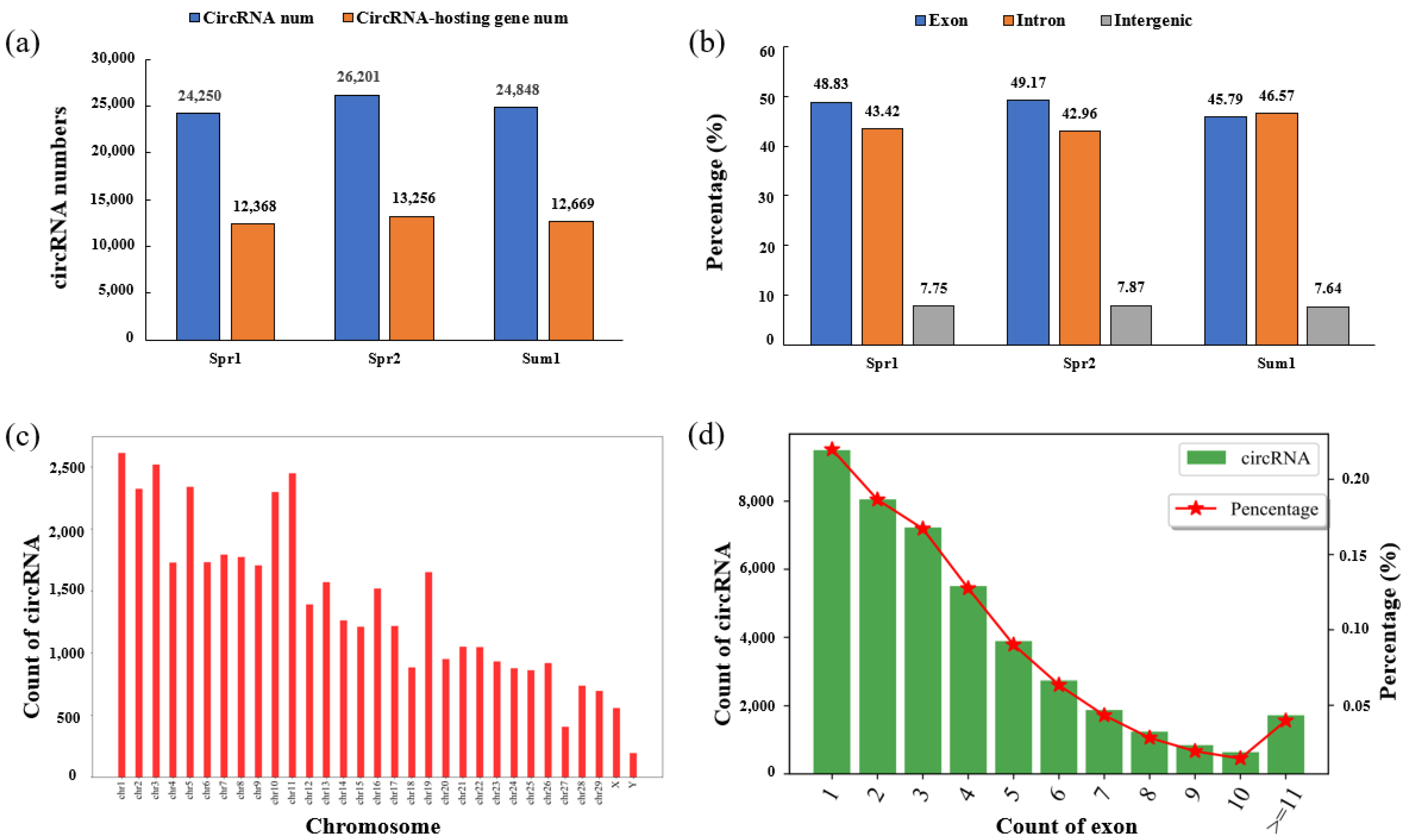
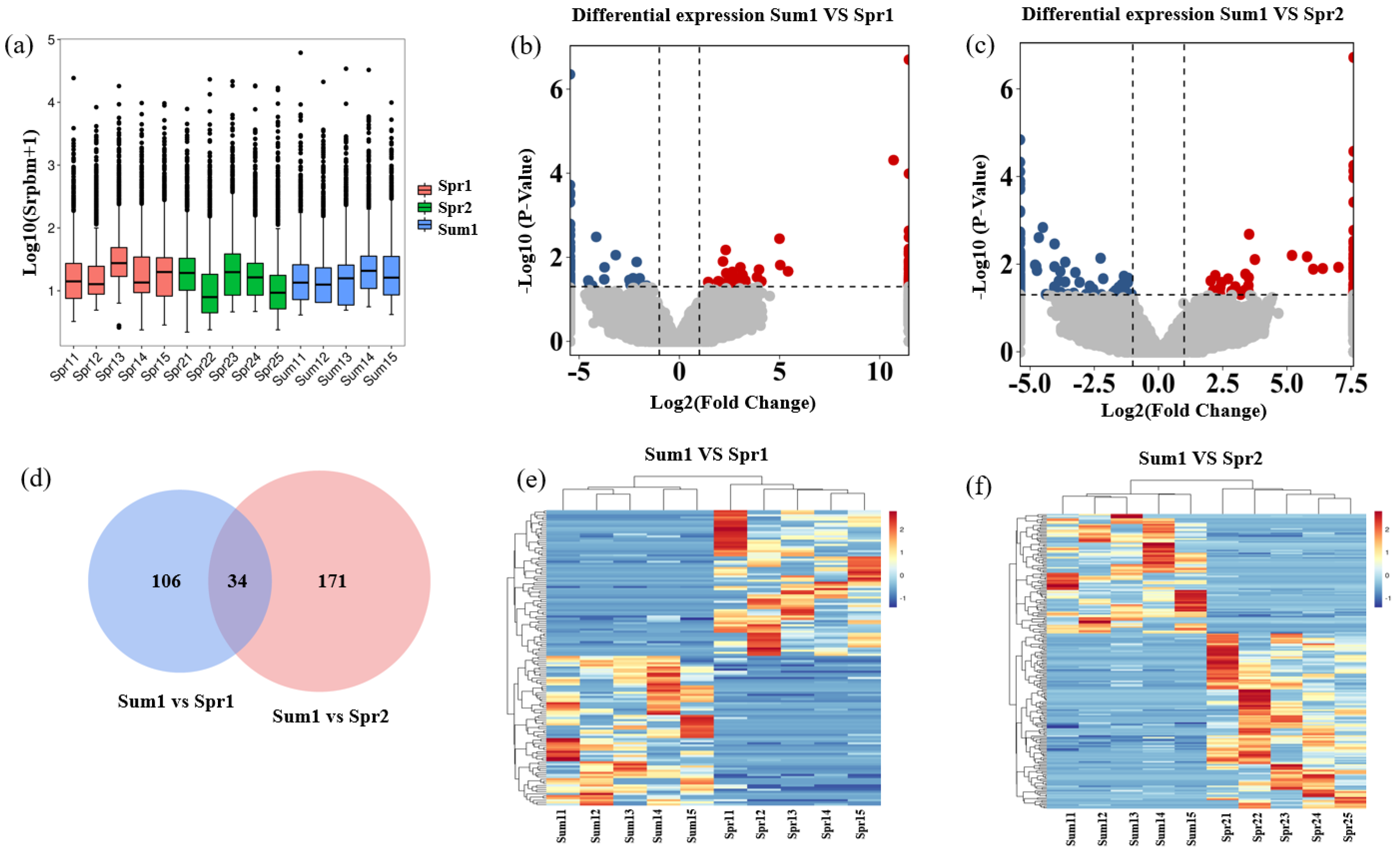
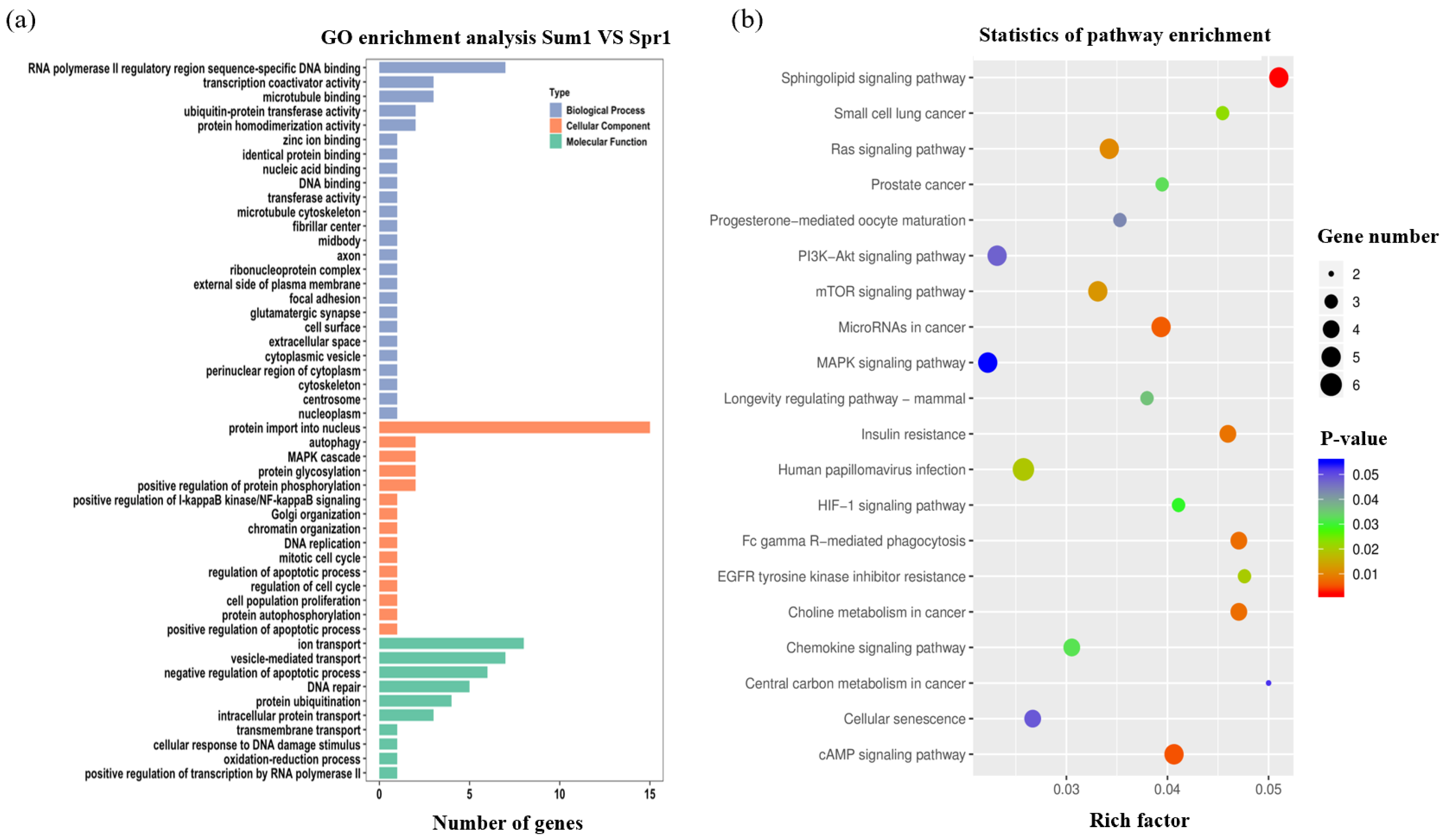
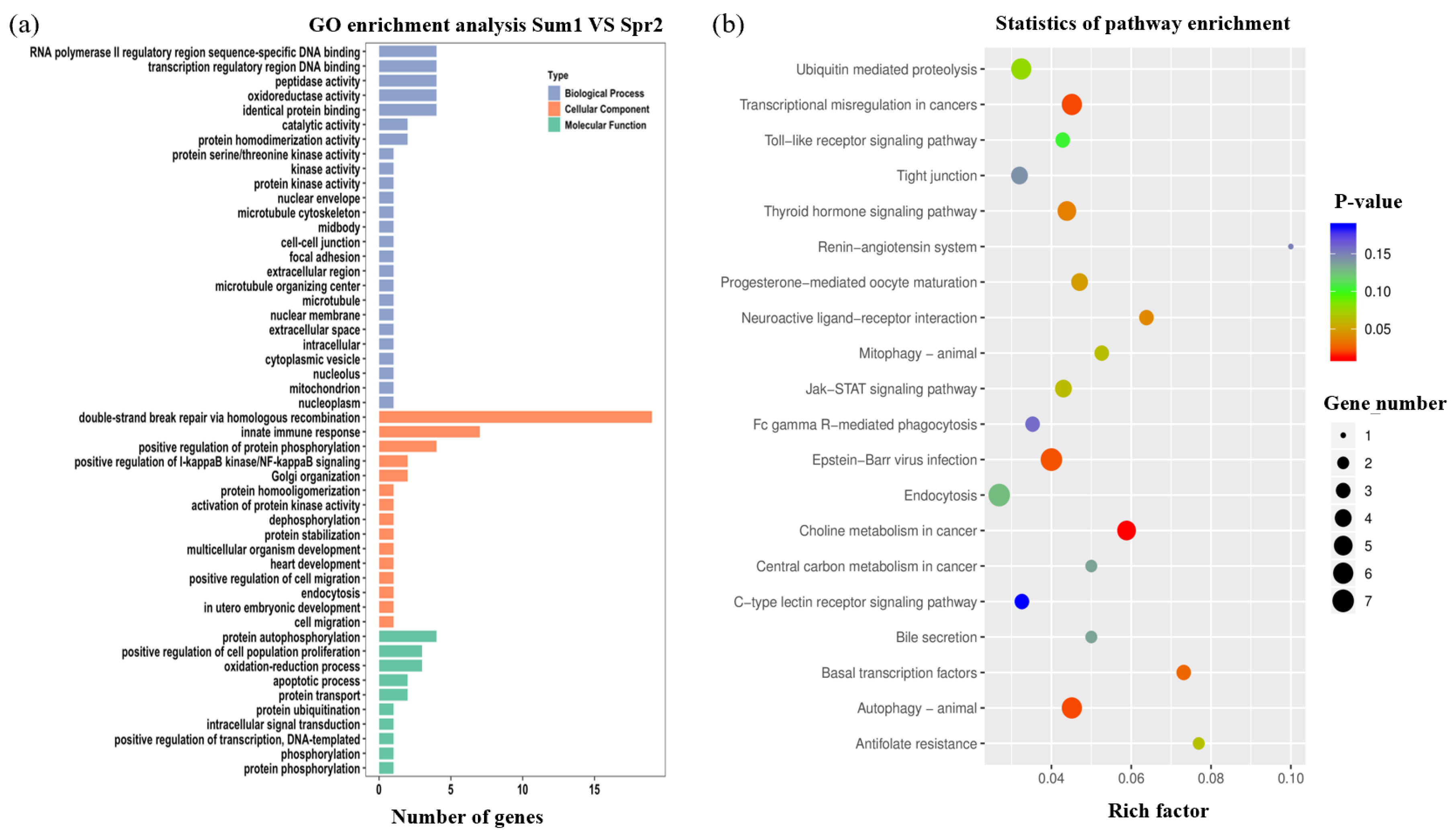

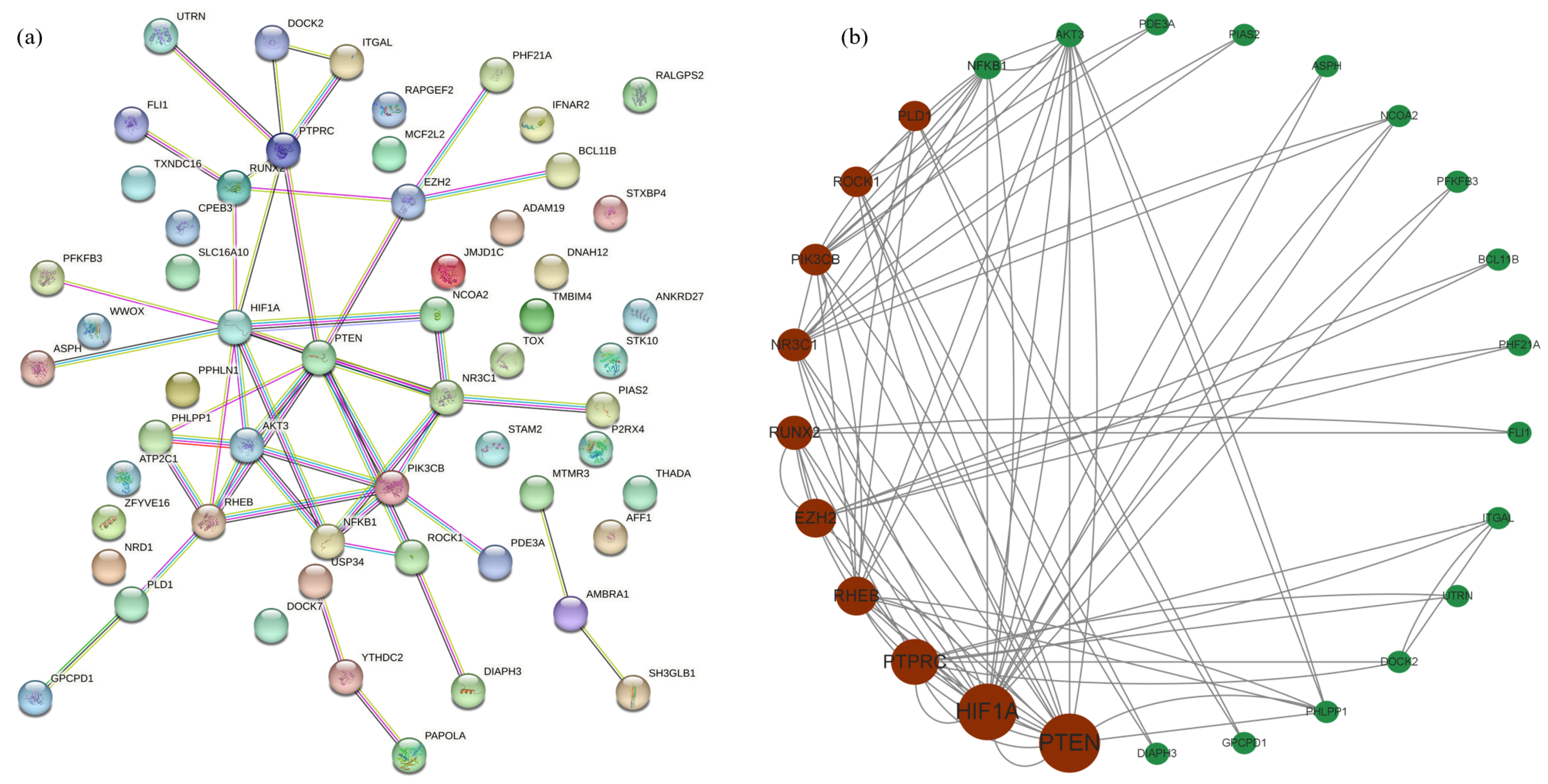
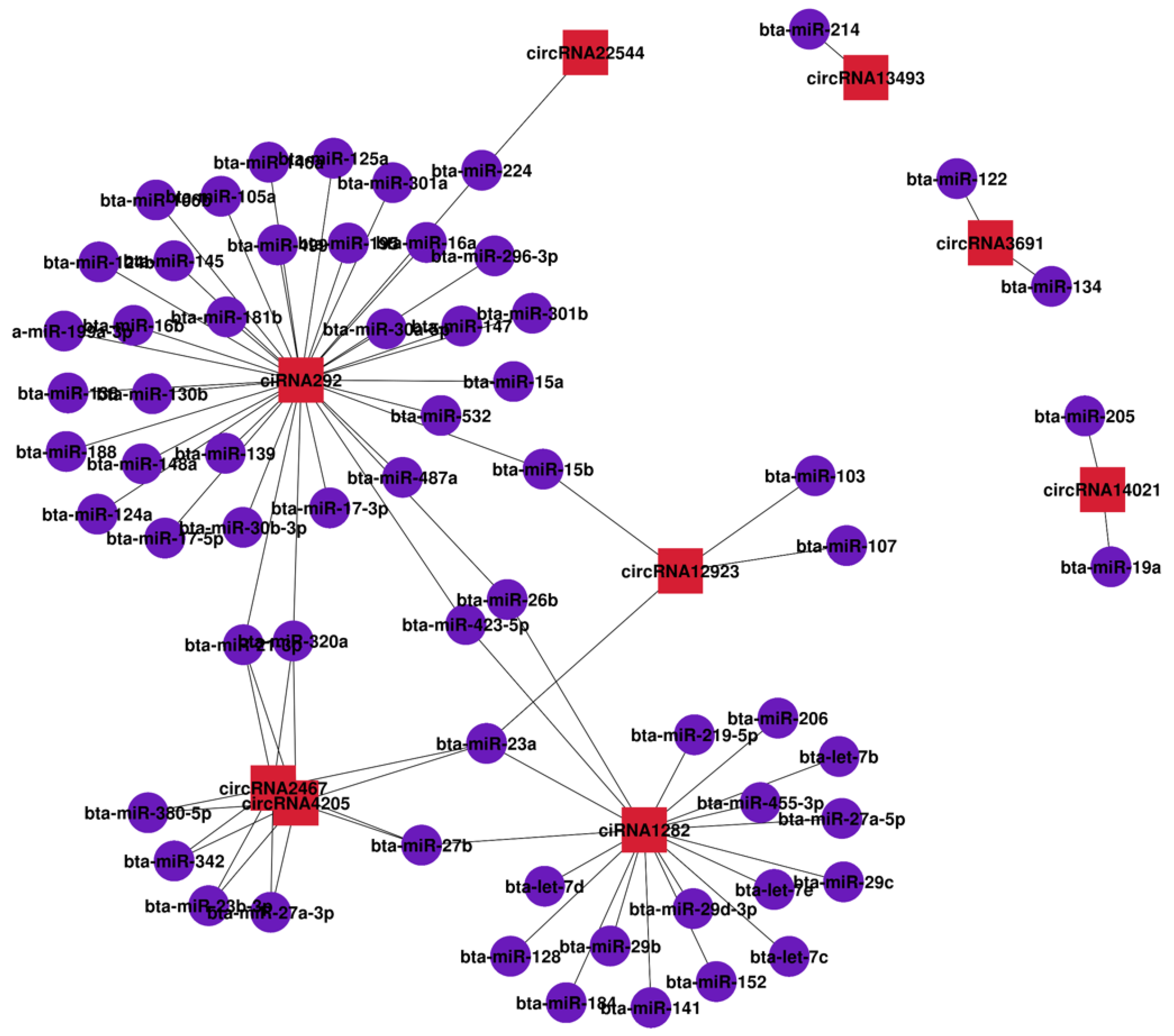

| Variable | Spr | Sum | p-Value 3 | |
|---|---|---|---|---|
| Spr1 (MEAN ± SD) 1 | Spr2 (MEAN ± SD) 1 | Sum1 (MEAN ± SD) 1 | ||
| Individual | 15 | 15 | 15 2 | NA |
| DIM (d) | 61.6 ± 10.62 | 137.53 ± 7.63 | 137.60 ± 10.62 | NA |
| 7AMY (Kg/day) | 40.91 ± 4.40 ab | 42.93 ± 3.25 a | 38.99 ± 3.64 b | <0.05 |
| MY (Kg) | 43.95 ± 3.89 a | 40.88 ± 2.05 b | 37.51 ± 5.36 c | <0.05 |
| RT (°C) | 38.63 ± 0.18 b | 38.58 ± 0.13 b | 38.96 ± 0.24 a | <0.05 |
| RR (breaths/min) | 38.80 ± 3.63 b | 37.60 ± 5.14 b | 88.4 ± 12.39 a | <0.05 |
| THI | 54.96 ± 3.27 | 81.08 ± 4.57 | <0.05 | |
| GO Term | CircRNA (Source Gene) | p-Value 1 |
|---|---|---|
| Guanyl-nucleotide exchange factor activity | CircRNA27860 (ANKRD27); circRNA27332 (RALGPS2); circRNA3628 (MCF2L2); circRNA27183 (DOCK7) | 0.001 |
| Cellular response to transforming growth factor beta stimulus | CiRNA3301 (WWOX); circRNA4205 (NR3C1) | 0.045 |
| Small GTPase-mediated signal transduction | CircRNA27332 (RALGPS2); circRNA13493 (RHEB); circRNA27183 (DOCK7) | 0.001 |
| Repressing transcription factor binding | CiRNA292 (RUNX2); circRNA4205 (NR3C1) | 0.001 |
| Cytosol | circRNA27437 (PPHLN1); circRNA4205 (NR3C1); circRNA11103 (STAM2); circRNA13493 (RHEB); ciRNA3301 (WWOX) | 0.001 |
| KEGG Term | CircRNA (Source Gene) | p-Value 1 |
|---|---|---|
| Choline metabolism in cancer | CircRNA13493 (RHEB); circRNA5677 (GPCPD1) | 0.005 |
| Endocytosis | CircRNA11103 (STAM2); circRNA27501 (ZFYVE16) | 0.025 |
| Longevity-regulating pathway | CircRNA13493 (RHEB) | 0.0057 |
| Accession | Source Gene | Sum1 vs. Spr1 | Sum1 vs. Spr2 | ||
|---|---|---|---|---|---|
| Regulation | p-Value 1 | Regulation | p-Value 1 | ||
| CircRNA1209 | PTEN | down | 0.01 | down | 0.15 |
| CiRNA1282 | HIF1A | down | 0.45 | down | 0.01 |
| CircRNA14021 | PTPRC | up | 0.04 | up | 0.47 |
| CircRNA13493 | RHEB | down | 0.01 | down | 0.04 |
| CircRNA22544 | EZH2 | up | 0.03 | up | 0.40 |
| CircRNA292 | RUNX2 | down | 0.02 | down | 0.00 |
| CircRNA2467 | NR3C1 | down | 0.44 | down | 0.05 |
| CircRNA4205 | NR3C1 | down | 0.01 | down | 0.00 |
| CircRNA3691 | PIK3CB | down | 0.02 | down | 0.09 |
| CircRNA12923 | ROCK1 | down | 0.01 | down | 0.39 |
| CircRNA5505 | PLD1 | down | 0.01 | down | 0.39 |
Disclaimer/Publisher’s Note: The statements, opinions and data contained in all publications are solely those of the individual author(s) and contributor(s) and not of MDPI and/or the editor(s). MDPI and/or the editor(s) disclaim responsibility for any injury to people or property resulting from any ideas, methods, instructions or products referred to in the content. |
© 2023 by the authors. Licensee MDPI, Basel, Switzerland. This article is an open access article distributed under the terms and conditions of the Creative Commons Attribution (CC BY) license (https://creativecommons.org/licenses/by/4.0/).
Share and Cite
Zhang, C.; Wang, S.; Hu, L.; Fang, H.; Chen, G.; Ma, X.; Yu, Y.; Wang, Y.; Xu, Q. Analysis of CircRNA Expression in Peripheral Blood of Holstein Cows in Response to Heat Stress. Int. J. Mol. Sci. 2023, 24, 10150. https://doi.org/10.3390/ijms241210150
Zhang C, Wang S, Hu L, Fang H, Chen G, Ma X, Yu Y, Wang Y, Xu Q. Analysis of CircRNA Expression in Peripheral Blood of Holstein Cows in Response to Heat Stress. International Journal of Molecular Sciences. 2023; 24(12):10150. https://doi.org/10.3390/ijms241210150
Chicago/Turabian StyleZhang, Congcong, Shuhui Wang, Lirong Hu, Hao Fang, Gong Chen, Xiaojuan Ma, Ying Yu, Yachun Wang, and Qing Xu. 2023. "Analysis of CircRNA Expression in Peripheral Blood of Holstein Cows in Response to Heat Stress" International Journal of Molecular Sciences 24, no. 12: 10150. https://doi.org/10.3390/ijms241210150
APA StyleZhang, C., Wang, S., Hu, L., Fang, H., Chen, G., Ma, X., Yu, Y., Wang, Y., & Xu, Q. (2023). Analysis of CircRNA Expression in Peripheral Blood of Holstein Cows in Response to Heat Stress. International Journal of Molecular Sciences, 24(12), 10150. https://doi.org/10.3390/ijms241210150









